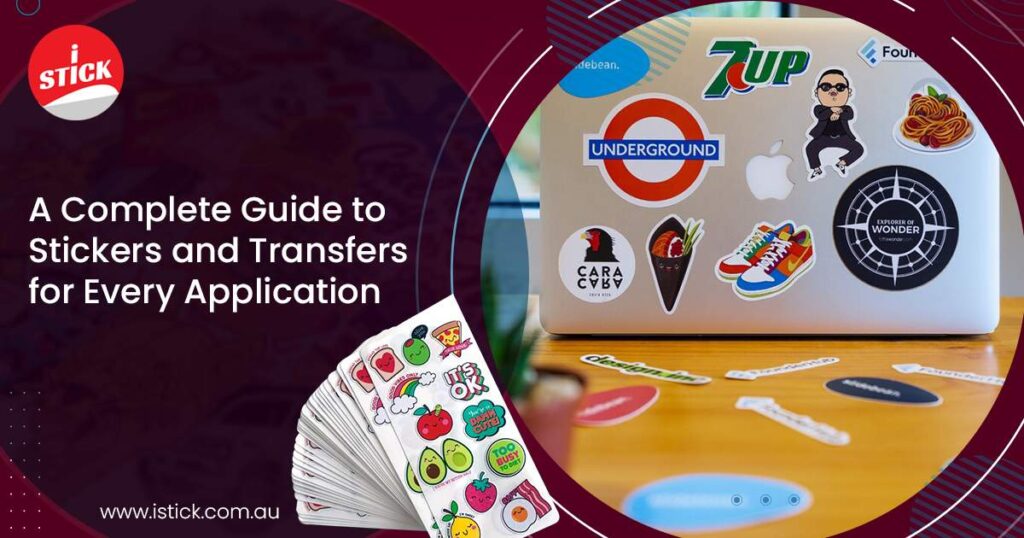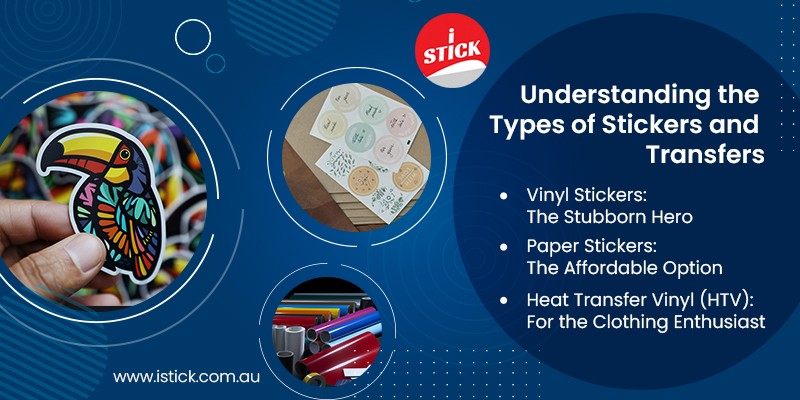
Have you ever tried to make a DIY project, only to realize that your sticker or transfer isn’t sticking properly? Or worse, you apply it, only to have it peel off the next day? We’ve all been there, right? You’re left wondering, What went wrong? or How can I make this last longer?
Whether you’re a small business owner looking to brand your products, a DIY enthusiast crafting custom designs, or someone looking to add a little personal touch to your home, stickers and transfers are an incredibly versatile solution.
But here’s the catch: Not all stickers and transfers are created equal, and picking the right one for your application can be tricky.
So, how do you choose the right sticker or transfer to make sure it lasts, sticks well, and gives that professional look you’re aiming for? Let’s read into the details, and by the end of this guide, you’ll have everything you need to make an informed decision, no matter your project.
Understanding the Types of Stickers and Transfers
First, let’s break down the different types of stickers and transfers to help you understand which one will work best for your needs.
-
Vinyl Stickers: The Stubborn Hero
Vinyl stickers are one of the most durable and versatile options available. Did you know that vinyl stickers can last up to 5-7 years outdoors without fading? That’s right! Whether you want to stick them on your car, windows, or your favorite water bottle, these bad boys aren’t going anywhere. They are waterproof, UV-resistant, and can handle extreme weather conditions.
Example:
Imagine that you’re designing custom car decals for your brand. You need them to stay intact, looking fresh through rain, snow, and the scorching sun. This is where vinyl comes to the rescue.

-
Paper Stickers: The Affordable Option
Now, paper stickers are on the opposite end of the spectrum. They’re perfect for short-term uses, like marketing materials or packaging. They might not survive harsh weather conditions, but when you need something that looks great at a low cost, paper is the go-to choice.
Example:
You’ve just launched a new product and need a batch of stickers to give away at a local event. Paper stickers are affordable, and they’ll serve their purpose without breaking the bank. However, make sure you don’t stick them somewhere exposed to the elements!
-
Heat Transfer Vinyl (HTV): For the Clothing Enthusiast
Ever wanted to customize your own t-shirt, hoodie, or tote bag? HTV is the solution. These stickers are applied using heat and pressure and are perfect for fabric applications. HTV can give you that professional look, similar to screen printing, but without the high cost and large setup.
Example:
Imagine starting a new clothing line, and you want to add your brand’s logo to a series of t-shirts. HTV allows you to apply that logo with precision, ensuring it won’t crack or peel after a few washes.
The Importance of Surface Compatibility
Here’s a question for you: Have you ever applied a sticker only for it to peel off because the surface wasn’t the right fit? It’s frustrating, right?
The secret to getting that perfect, long-lasting sticker or transfer lies in choosing the right surface. For instance, vinyl stickers stick well to smooth, non-porous surfaces like glass, plastic, and metal. Paper stickers, on the other hand, work best on smooth surfaces, but they may not hold up well on textured surfaces.
Choosing the Right Adhesive
Another consideration is the adhesive used in stickers and transfers. Not all adhesives are created equal, and understanding the difference can save you time and frustration.
-
Permanent Adhesive:
Ideal for long-term applications, such as vehicle decals or product branding. It’s designed to withstand the test of time, but removing it can be a challenge.
-
Removable Adhesive:
Great for applications where you need to peel the sticker off later without leaving a mess. Think about those “For Sale” signs or temporary window decorations.
-
Low-Tack Adhesive:
Perfect for surfaces that need to be repositioned or for delicate items like walls. It won’t damage your surface when removed.
Example:
Let’s say you’re a business owner creating labels for your products. You want them to stick through shipping but be easy to remove without leaving a residue. Low-tack adhesive will do the job perfectly.
Applying Stickers and Transfers Like a Pro
Here’s the part that often trips people up: How to actually apply the sticker or transfer. After all, the application process can make or break the final look. So, let’s go over a few tips:
-
Clean the Surface:
It seems simple, but the number of times a sticker fails because the surface wasn’t properly cleaned is unbelievable. Dust, oils, or residues can prevent the sticker from adhering properly.
-
Use a Transfer Tape:
If you’re working with intricate designs or transfers, transfer tape is your best friend. It ensures the design is applied in one go, without shifting.
-
Avoid Bubbles:
Use a squeegee or credit card to smooth out any air bubbles as you apply the sticker. This will help achieve a clean, professional finish.
You’ve got everything ready, the perfect sticker, the ideal surface, the right adhesive—but did you apply it correctly? Let’s see…
When Things Go Wrong
Now, let’s talk about the times when it doesn’t go as planned. Have you ever applied a sticker and watched it start to peel off or fade almost immediately? Let’s break down what might have happened:
-
Wrong Surface:
This is the most common mistake. As we’ve mentioned before, not all stickers are suitable for all surfaces.
-
Incorrect Application:
Not pressing down hard enough or not smoothing out air bubbles can result in a less-than-ideal finish.
-
Bad Adhesive Quality:
Cheap adhesives can leave behind sticky residue or cause stickers to peel prematurely.
You’ve just finished a custom branding project with vinyl stickers for your new product line, but a few days later, they start to peel. Upon inspection, you realize that the surface wasn’t prepared properly, and there was dust preventing the sticker from sticking. It’s a tough pill to swallow, but it’s a learning experience!
Conclusion
By now, you should feel a lot more confident about choosing the right sticker or transfer for your project. The key takeaway? Every application is unique. Whether you’re applying a sticker to your car, customizing a t-shirt, or branding a product, understanding the material, adhesive, and surface compatibility will ensure you get the best results.
So, the next time you start a project, remember: choose wisely, apply carefully, and watch your designs come to life in a way that will leave a lasting impression.
Ready to tackle your next sticker project? At iStick, we offer a wide range of high-quality stickers and transfers designed for every application—whether you’re looking for something durable, easy to apply, or perfect for any surface.
Visit iStick today and let’s make your designs stick—perfectly!
